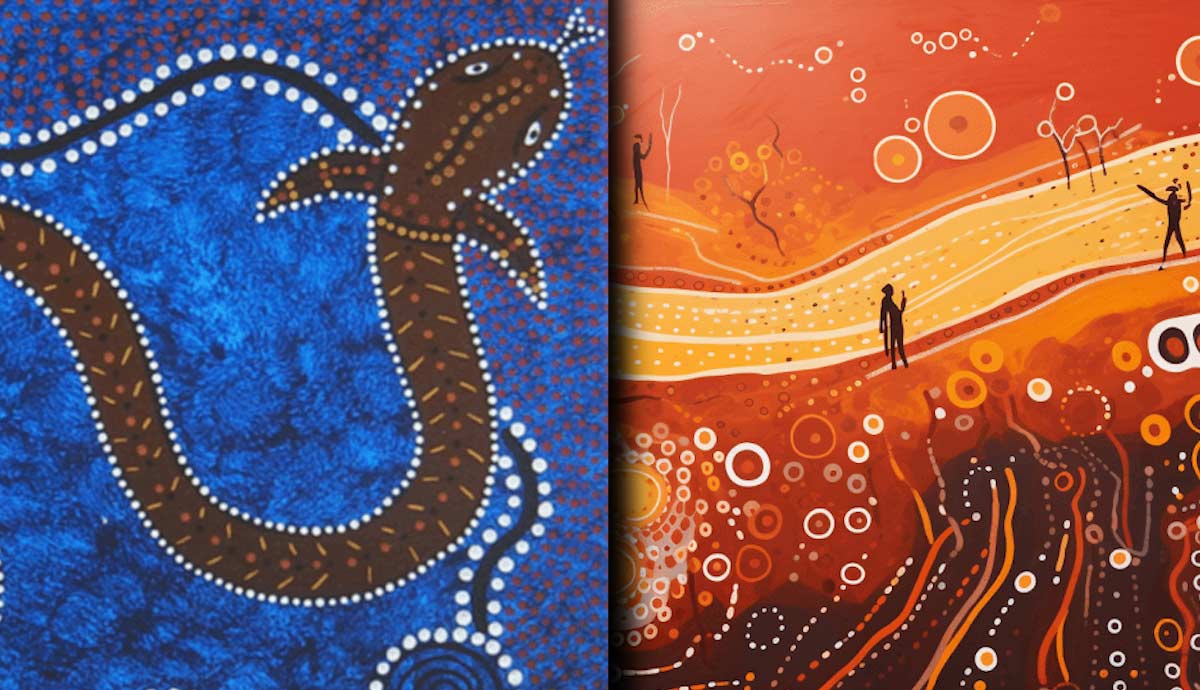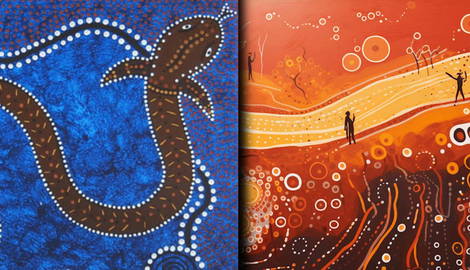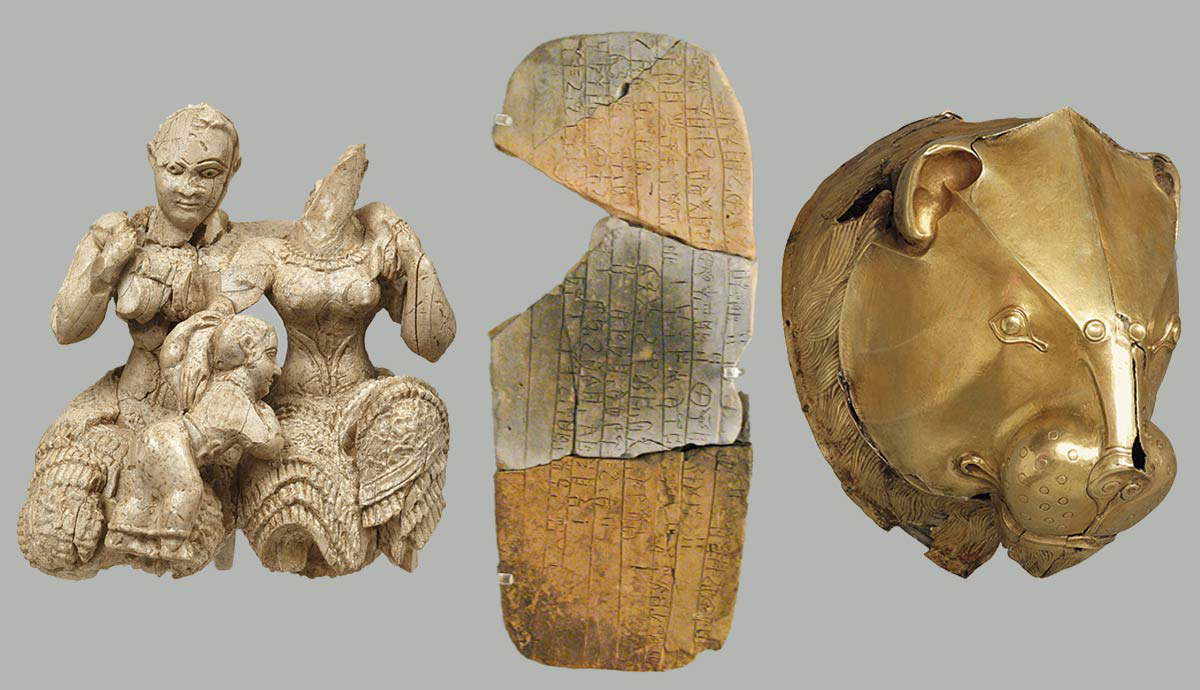
Aboriginal Australians have lived in Australia for 65,000 years. While they are often described as a cohesive community, they are a group of diverse and culturally distinctive tribes who speak more than 250 languages. Something that the Aboriginal people share is the “Dreaming” or “Dreamtime,” a term coined by anthropologists to describe an earlier time in Aboriginal history when the world was occupied by great ancestors, some supernatural. Aboriginal people tell stories about this time and these people, and these stories often explain why the world is as it is today.
1. The Rainbow Serpent

A long time ago, when the earth was sleeping and nothing moved, a great Rainbow Serpent lived under the earth. One day, the serpent awoke and slithered above the earth. Curious about the new world and rejuvenated from her long sleep, the serpent traveled far and wide. As she slithered about, she left winding tracks with her body, before eventually returning to where she started.
When she returned, she called on the frogs to come out of hibernation and join her in the new world. When they emerged, their bellies were full of water that they were storing during their sleep. The Rainbow Serpent tickled their stomachs and as the frogs laughed, the water they were holding spilled out over the earth. The water ran into the tracks left by the Rainbow Serpent, forming rivers and lakes.
As the land now had moisture, grass and trees started to grow. This activity awoke the other animals that were sleeping, and they joined the Rainbow Serpent.

Each animal had their own area, whether it was rocks or plains, and followed rules set by the Rainbow Serpent. This allowed everything to live in harmony, gathering food and other necessities within tribal groups.
Over time, some started to argue over the rules. The Rainbow Serpent promised to reward those who followed the rules by granting them human form. She said that she would punish those who broke the rules by turning them to stone so that they could no longer walk the earth.
Those who broke the rules became mountains and hills, and those who followed the rules became human tribes. The Rainbow Serpent gave each tribe an animal totem, such as a kangaroo or an emu. To ensure that all animals survived, the Rainbow Serpent declared that no human should eat their own totem, but only the totem animals of others. Many aboriginal tribes still refrain from eating their totem animals to this day.
2. The Seven Sisters

This is one of the most consistent stories across different Aboriginal tribes and relates to the star cluster the Pleiades, which is part of the constellation Taurus. This small star cluster draws attention because it appears to rise above the horizon soon after sunset and keeps a low trajectory, appearing to be close to the Earth.
The seven sisters are sky people who descended to the earth one day where they encountered a group of men who had never seen women before. As soon as they saw the sky women they were overcome with desire and began to chase them. The women managed to escape by beating them with digging sticks.
The sisters then encountered an evil spirit called Yurlu. He had also been following the women because he wanted to take one for a wife, but the union was forbidden. He tried many tricks to capture the sisters and almost succeeded on several occasions.
Eventually, the sisters sought refuge in a cave near a waterhole known as Puyata. Even there Yurlu pursued them, watching them from a stone mound, which still stands in the area today. The sisters escaped him again by using their digging sticks to create an escape route at the back of the cave.
Unperturbed, Yurlu used sorcery to send his penis in pursuit of the sisters in the form of a carpet snake. The sisters captured the snake intending to eat it, but when they realized that it was a trap, they threw the snake away and fled to the horizon. Yurlu then took the form of the wind to continue his pursuit and became the Orion constellation that follows the Pleiades.
3. Tiddalik the Frog

Tiddalik was the largest frog ever known. One day he woke up and was very thirsty, so he drank all the fresh water in the world. This meant that soon trees and other creatures started dying. Worried about what to do, the other creatures shared many ideas until a wise wombat suggested that if they could make Tiddalik laugh, the water would flow out of his mouth.
The animals tried many different things to make Tiddalik laugh. The kookaburra told his funniest story. The kangaroo jumped over an emu. The lizard walked around on two legs with his stomach protruding. But nothing seemed to entertain Tiddalik.
Finally, an eel named Nabunum, who had been driven to land by the drought, started to dance for Tiddalik. It danced faster and faster, tying itself in knots. Eventually, the frog burst out laughing and the water gushed from his mouth, restoring moisture to the world.
The story teaches us how precious the water supply is, not to be greedy or selfish, and the value of a good laugh.
4. Koobor the Koala

A long time ago, Koobor was an orphaned boy who was not treated well by his people. In particular, he was never given enough water to drink. One morning, everyone else went out to collect food and left Koobor behind. He realized that he could drink as much water from the water buckets as he desired.
Koobor realized that he should save some water for later, so he hung the buckets on the low branches of a tree and then climbed on a branch himself. He chanted a special song that allowed the tree to grow and become one of the largest in the forest, lifting the water high up into the air.
When the people returned, they were tired and thirsty. They immediately became angry when they saw what had happened to the water. They demanded that Koobor return to the water, and when he refused, two men from the community climbed the tree, beat Koobor, and threw him to the ground.
Koobor’s body was shattered but transformed into that of a Koala. Koobor then climbed the nearest tree and sat at the top for safety. There at the top of the tree, he eats Eucalyptus leaves and does not need water to survive. He also declared that the people cannot kill koalas for food, or they will call forth severe droughts.
This is a complex story that explains why the koala does not drink water and the cause of droughts, which are common in Australia. It also informs us about community dynamics.
5. How the Kangaroo Got Its Pouch

A mother kangaroo was having trouble managing her young joey. Whenever she turned her back, he would hop off and explore. She worried that she would lose him.
One day, a weak and old wombat approached the mother and joey. He explained that he was sick and blind and had no friends. The mother kangaroo felt sorry for the wombat and said that she would be his friend. She agreed to let the wombat hold on to her tail so that she could lead him to water. But it was a long journey because the wombat kept falling off and the joey kept wandering off.
The old wombat was grateful when they reached the waterhole and drank deeply. But now he complained that he was hungry, so the kangaroo took him somewhere to eat in the same way. The joey was tired and wanted his mother to carry him, but her arms were too short.
When they reached their destination, the wombat ate his fill and seemed happy. But suddenly the mother kangaroo sensed danger. A hunter with a boomerang appeared and was intent on hunting the wombat. To protect her friend, the mother kangaroo jumped up and down to get the hunter’s attention and then led him off on a chase, escaping thanks to her superior speed.

When the mother kangaroo returned to where she had left her joey and the wombat, they weren’t there. She desperately looked everywhere for them while crying. Eventually, she found her joey asleep under a gum tree and was overjoyed. She asked him what had happened to the old wombat, and the joey said that he had disappeared.
But the wombat was not a wombat. He was a spirit in search of a gentle and generous soul. That night he returned and left the mother kangaroo the gift of a string bag. When the kangaroo awoke, she wasn’t sure what to do with it, so she tied it around her waist. The spirit then turned it into a pouch. This became a place where the mother could carry and protect her joey.
This explains why the kangaroo has a pouch and teaches that kindness is often rewarded.
The World of the Dreamtime

These are only a few of the many stories told about the Dreamtime. There are also tales about how the sun was made, the birth of butterflies, the first fire, and many more. They tell the story of a unique culture that developed largely in isolation for 65,000 years, which makes the parallels with myths and stories from other parts of the world particularly interesting.










